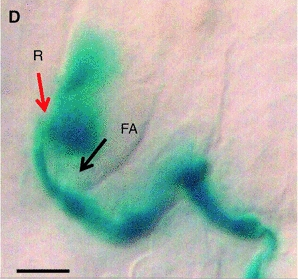Paper of the month (May 2013)
 . .
An new research article in Plant Reproduction has uncovered evidence in Arabidopsis for pollen tube entry into the synergid cell at a site besides the filliform apparatus, a specialized structure that was thought to be perhaps the only site of pollen tube entry into the synergid cell. In the image above, the location of the filiform apparatus (FA) is denoted by the black arrow and the red arrow points to the site in the synergid cell where the pollen tube (marked in blue) has entered and lysed. Obviously, the sites pointing by red and black arrows are distinct, leading to the conclusion that pollen tubes can enter at a site besides the filiform apparatus.
Pollen tube entry into the synergid cell of Arabidopsis is observed at a site distinct from the filiform apparatus
Yehoram Leshem, Cameron Johnson, and Venkatesan Sundaresan
Departments of Plant Biology and Plant Sciences, University of California-Davis, Davis, California, USA
Reference: Lesham et al (2013) Plant Reprod.
doi: 10.1007/s00497-013-0211-1
PDF file of the article can be downloaded here
Abstract
In higher plants, the double-fertilization process begins with the successful delivery of two sperm cells to the female gametophyte. The sperms cells are carried by a pollen tube that upon arrival at the micropylar end of the female gametophyte, bursts, and discharges its content into one of two specialized cells called the synergid cells. At their micropylar ends, both synergid cells form a thickened cell wall with a unique structure called the filiform apparatus. The filiform apparatus is believed to play a major role in pollen tube guidance and reception. It has also been assumed that the pollen tube enters the receptive synergid cell through the filiform apparatus. Here, we show that in Arabidopsis ovules, the arriving pollen tube appears to grow beyond the filiform apparatus to enter the synergid cell at a more distant site, where the tube bursts to release its contents. Thus, fertilization in Arabidopsis might involve two spatially and temporally separable stages, recognition and entry, with the latter apparently not requiring the filiform apparatus.
-----------------------------------------------------------------------------
Click here for previously featured paper of the month.
|